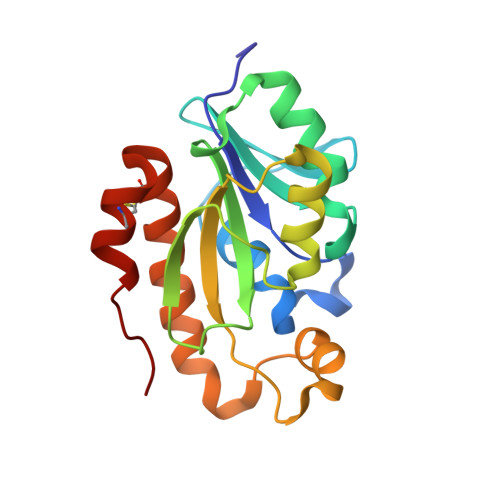High-resolution crystal structure of peptidyl-tRNA hydrolase from Thermus thermophilus.
Matsumoto, A., Uehara, Y., Shimizu, Y., Ueda, T., Uchiumi, T., Ito, K.(2019) Proteins 87: 226-235
- PubMed: 30520515
- DOI: https://doi.org/10.1002/prot.25643
- Primary Citation of Related Structures:
5ZX8 - PubMed Abstract:
Peptidyl-tRNA hydrolase (Pth) cleaves the ester bond between the peptide and the tRNA of peptidyl-tRNA molecules, which are the products of defective translation, to recycle the tRNA for further rounds of protein synthesis. Pth is ubiquitous in nature, and its activity is essential for bacterial viability. Here, we have determined the crystal structure of Pth from Thermus thermophilus (TtPth) at 1.00 Å resolution. This is the first structure of a Pth from a thermophilic bacterium and the highest resolution Pth structure reported so far. The present atomic resolution data enabled the calculation of anisotropic displacement parameters for all atoms, which revealed the directionality of the fluctuations of key regions for the substrate recognition. Comparisons between TtPth and mesophilic bacterial Pths revealed that their structures are similar overall. However, the structures of the N- and C-terminal, loop-helix α4, and helix α6 regions are different. In addition, the helix α1 to strand β4 region of TtPth is remarkably different from those of the mesophilic bacterial Pths, because this region is 9 or 10 amino acid residues shorter than those of the mesophilic bacterial Pths. This shortening seems to contribute to the thermostability of TtPth. To further understand the determinants for the thermostability of TtPth, we compared various structural factors of TtPth with those of mesophilic bacterial Pths. The data suggest that the decreases in accessible surface area and thermolabile amino acid residues, and the increases in ion pairs, hydrogen bonds, and proline residues cooperatively contribute to the thermostability of TtPth.
Organizational Affiliation:
Faculty of Science, Department of Biology, Niigata University, Niigata, Japan.
















